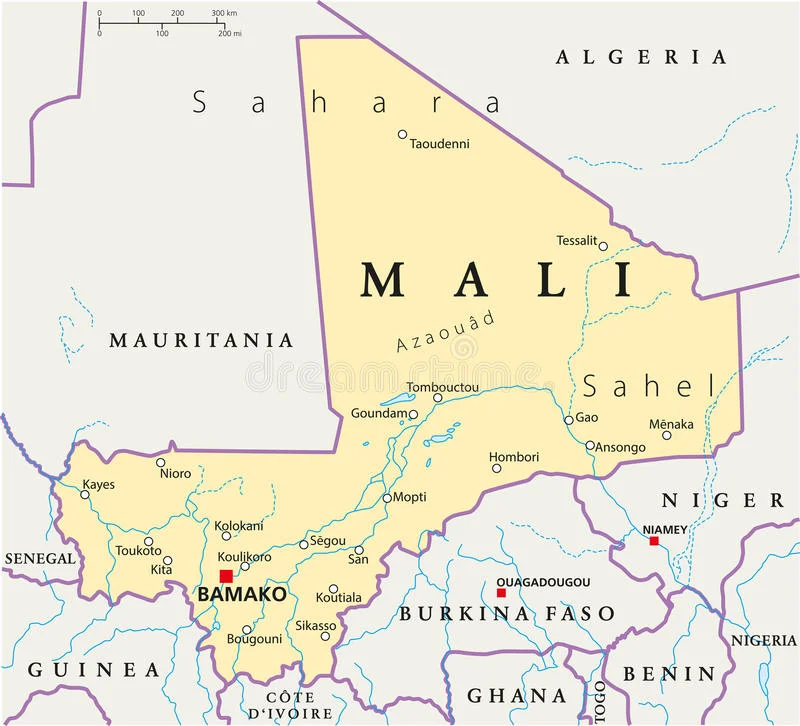The principal Dogon area is bisected by the Bandiagara Escarpment, a sandstone cliff of up to 500 m (1,640.42 ft) high, stretching about 150 km (90 miles). To the southeast of the cliff, the sandy Séno-Gondo Plains are found, and northwest of the cliff are the Bandiagara Highlands. Historically, Dogon villages were established in the Bandiagara area a thousand years ago because the people collectively refused to convert to Islam and retreated from areas controlled by Muslims.
Dogon insecurity in the face of these historical pressures caused them to locate their villages in defensible positions along the walls of the escarpment. The other factor influencing their choice of settlement location was access to water. The Niger River is nearby and in the sandstone rock, a rivulet runs at the foot of the cliff at the lowest point of the area during the wet season.
Among the Dogon, several oral traditions have been recorded as to their origin. One relates to their coming from Mande, located to the southwest of the Bandiagara escarpment near Bamako. According to this oral tradition, the first Dogon settlement was established in the extreme southwest of the escarpment at Kani-Na.
Kani-Kombole Mosque
Kani-Kombole Mosque
Kani Kombole Mosque
Celebration of Tabaski in Kani Kombole on Dec 31
The Imam
The mosque in the village of Ennde
The Ennde mosque
The Ennde Mosque
Dogon Taxi
We travelled on an ox cart from village to village
Dogon Taxi
Tellem
The village of Tellem
Villages are built along escarpments and near a source of water. On average, a village contains around 44 houses organized around the 'ginna', or head man's house. Each village is composed of one main lineage (occasionally, multiple lineages make up a single village) traced through the male line. Houses are built extremely close together, many times sharing walls and floors.
Dogon villages have different buildings:
Male granary: storage place for pearl millet and other grains. Building with a pointed roof. This building is well protected from mice. The amount of filled male granaries is an indication for the size and the richness of a guinna.
Female granary: storage place for a woman's things, her husband has no access. Building with a pointed roof. It looks like a male granary but is less protected against mice. Here, she stores her personal belongings such as clothes, jewelry, money and some food. A woman has a degree of economic independence, and earnings and things related to her merchandise are stored in her personal granary. She can for example make cotton or pottery. The number of female granaries is an indication for the number of women living in the guinna.
Tógu nà (a kind of case à palabres): a building only for men. They rest here much of the day throughout the heat of the dry season, discuss affairs and take important decisions in the toguna. The roof of a toguna is made by 8 layers of millet stalks. It is a low building in which one cannot stand upright. This helps with avoiding violence when discussions get heated.
Punulu (a house for menstruating women): this house is on the outside of the village. It is constructed by women and is of lower quality than the other village buildings. Women having their period are considered to be unclean and have to leave their family house to live during five days in this house. They use kitchen equipment only to be used here. They bring with them their youngest children. This house is a gathering place for women during the evening. This hut is also thought to have some sort of reproductive symbolism due to the fact that the hut can be easily seen by the men who are working the fields who know that only women who are on their period, and thus not pregnant, can be there.
Ireli
Ireli
Tellem
Tellem
Ireli
Tellem
The fetish houses in Tellem
The fetish houses in Tellem
Fetish houses in Tellem
Tellem
During the eleventh century, a hunter-gatherer group known as the Tellem constructed dwellings high on the cliff face as protection from raiders and hostile neighbors. Along with occupying caves on the escarpment face, the Tellem built cylindrical granaries in shallow recesses of the rock. Possibly as a result of conflict with the Dogon and neighboring groups, the Tellem---described by the Dogon as “the ones we found”---abandoned the escarpment sometime in the 1800s, leaving behind pottery, baskets, leather bags used to carry water, jewelry, and other items.
Village bell
A goat being prepared for the celebration of Tabaski
Tógu nà (a kind of case à palabres): a building only for men. They rest here much of the day throughout the heat of the dry season, discuss affairs and take important decisions in the toguna. The roof of a toguna is made by 8 layers of millet stalks. It is a low building in which one cannot stand upright. This helps with avoiding violence when discussions get heated.







































































